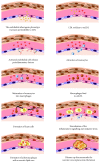Targeting Early Atherosclerosis: A Focus on Oxidative Stress and Inflammation
- PMID: 31354915
- PMCID: PMC6636482
- DOI: 10.1155/2019/8563845
Targeting Early Atherosclerosis: A Focus on Oxidative Stress and Inflammation
Abstract
Atherosclerosis is a chronic vascular inflammatory disease associated to oxidative stress and endothelial dysfunction. Oxidation of low-density lipoprotein (LDL) cholesterol is one of the key factors for the development of atherosclerosis. Nonoxidized LDL have a low affinity for macrophages, so they are not themselves a risk factor. However, lowering LDL levels is a common clinical practice to reduce oxidation and the risk of major events in patients with cardiovascular diseases (CVD). Atherosclerosis starts with dysfunctional changes in the endothelium induced by disturbed shear stress which can lead to endothelial and platelet activation, adhesion of monocytes on the activated endothelium, and differentiation into proinflammatory macrophages, which increase the uptake of oxidized LDL (oxLDL) and turn into foam cells, exacerbating the inflammatory signalling. The atherosclerotic process is accelerated by a myriad of factors, such as the release of inflammatory chemokines and cytokines, the generation of reactive oxygen species (ROS), growth factors, and the proliferation of vascular smooth muscle cells. Inflammation and immunity are key factors for the development and complications of atherosclerosis, and therefore, the whole atherosclerotic process is a target for diagnosis and treatment. In this review, we focus on early stages of the disease and we address both biomarkers and therapeutic approaches currently available and under research.
Figures




References
Publication types
MeSH terms
LinkOut - more resources
Full Text Sources
Other Literature Sources
Medical

